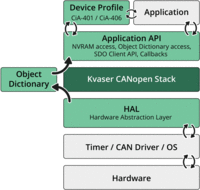CAN Info Mail
This monthly email is for all CAN fellows.
October 2023
A word from the CiA Managing Director

The FDIS (final draft international standard) version of ISO 11898-2 has been submitted for international balloting. Only editorial and general comments are allowed. Technical comments are not more possible. In comparison with the DIS (draft international standard) version some significant technical changes have been introduced in order to achieve interoperability of different implementations in stand-alone transceivers and in system base chips (SBC). Additionally, the FDIS version clarifies implementation options by means of three specified parameter sets. Legacy implementations based on ISO 11898-2:2016 are still compliant with the FDIS version, but some of them are not more recommended for new designs. It is intended to reduce the number of implementation variants.
In general, there are three options recommended, which support optionally a low-power mode or a selective wake-up function:
- CAN FD (flexible data rate), supporting bit rates up to 5 Mbit/s;
- CAN SIC (signal improvement capability) transceivers, supporting bit rates up to 8 Mbit/s;
- CAN SIC XL transceivers, supporting PWM (pulse-width modulation) coding enabling bit rates up to 20 Mbit/s.
Of course, the maximum achievable bit rate depends on the network design, especially on the chosen network topology and the selected physical layer components, including cable as well as connectors. Any impedance mismatch causes ringing as well as not terminated stubs. This can lead to bit-rate limitations. CiA develops guidelines and recommendations for CAN CC (classic), CAN FD, and CAN XL network designs. I expect also some research results for network designs at the next international CAN Conference (iCC) scheduled for May 2024. The iCC will take place in Baden-Baden, Germany.

Spelling of different CAN generations
This topic was discussed at the CiA Business Committee (BC) meeting on September 15, 2023. The committee has decided that CAN and CANopen are considered as generic technology terms, covering all generations of CAN respectively CANopen.
When referring to a specific CAN generation, the following terms shall be used:
- CAN classic (abbreviated: CAN CC)
- CAN flexible data rate (includes CC) (abbreviated: CAN FD)
- CAN extended data length (includes CC and FD) (abbreviated: CAN XL)
When referring to a specific CANopen generaton, the following terms should be used:
- CANopen classic (abbreviated: CANopen CC)
- CANopen FD (CANopen FD does not include CANopen CC functionality)
CiA activities at X (formerly Twitter)
The members of the CiA Business Committee (BC) also discussed about CiA’s activities at the X social media platform. This led to the following results:
- Some CiA members have already stopped their activities on X
- CiA was requested to set all activities on X, on hold.
- CiA BC is monitoring the business conduct of X. In case there are no significant changes, the BC shall decide to close the CiA X-account.
SIG 3,3-V transceiver in preparation
The CiA Interest Group (IG) Lower layers has decided to establish a Special Interest Group (SIG) to develop CiA specifications for 3,3-V transceivers. It is intended that 3,3-V components can be mixed with 5-V transceivers. Interested parties may contact CiA office. In a first step, only CAN HS (high-speed) transceivers and CAN FD transceivers are considered; CAN SIC transceivers and CAN SIC XL transceivers are not yet in the scope. When the document is mature, it is intended to submit it for ISO standardization.
Submission of DIN 4630 to ISO
The DIN German standardization body is going to submit the DIN 4630 document standardizing commercial vehicle body application networks (based on CANopen or J1939) to the ISO international standardization body. It is intended to release the 2nd edition as an ISO standard. This ISO standard should introduce a secondary display for the body application connected to the in-vehicle networks. Furthermore, it should support additional body applications (e.g. hook loaders) and an (e)PTO (power take-off) manager.
CiA members, who are commercial vehicle body builders or suppliers, should contact CiA office, which coordinates this standardization activity in close cooperation with the CiA member Palfinger.
CleANopen in Poland
The CiA 422 application profile for refuse-collecting vehicles, also known as CleANopen, is standardized in EN 16815:2019. Since years, it is used in France, Germany, Switzerland, and some other European countries. Recently, the city of Warsaw, the capital of Poland, has released a tender for use of refuse-collecting vehicles based on CleANopen.
CiA 603 updated
CiA has released the version 1.1.0 of the CAN network time management specification as Draft Specification (DS), which has been editorially improved and substituted non-inclusive terms.
CiA 603 specifies the time-stamping, when transmitting and receiving CAN data frames in CAN CC and CAN FD formats. This is used to synchronize time-bases in different nodes, to achieve a synchronized network time. Synchronized time-bases are needed for example in advanced driver assistance systems (ADAS), event data recording, and coordinated actuations. This time synchronization can be used in particular in Autosar environments and complies with Autosar specifications.
CiA workshop: Digital construction site 4.0
On October 19, 2023 (13:00 to 15:00, UTC+2), CiA organizes a free-of-charge online workshop to evaluate current requirements for networking of construction machineries and applications. Construction machines use telematics solutions to increase the quality, precision, workers’ safety, and work efficiency. Machine utilization, provision of operating media and building materials can be optimized on the digital construction site. Typically, the base for the digitalization are CAN-based embedded control networks. CiA has already specified device and application profiles for the construction machineries. These harmonize configuration, diagnostic, and process data accessible by means of standardized access services. Specified interfaces simplify integration of CAN-based applications into the cloud. The speakers are going to provide an overview about the existing CiA profiles and to identify further requirements for modern construction applications.
Non-members can participate in the workshop on request. For registration, please contact secretary(at)can-cia.org.
Interlift 2023: Meet CiA experts
CiA is an exhibitor on the Interlift tradeshow (hall 3, stand 3111) from October 17 to 20 in Augsburg (Germany). On its stand, CiA informs visitors about the latest activities of the CANopen Lift community and offers a poster showing CANopen Lift application (CiA 417) principles. Several companies present their CANopen Lift products on CiA’s panel walls.
It is possible to schedule an appointment with a CiA expert in advance. Therefore, please contact exhibition(at)can-cia.org.
CiA webinar: CANopen Lift
As a foretaste for the Interlift tradeshow, CiA offers a 45-minutes webinar about CANopen Lift on October 10, 2023. It starts at 16:00 (UTC+2) and informs about the available solutions and ongoing CiA activities in this application field. The webinar held in English language, ends with a Q&A session, in which attendees can discuss their questions.
Participation is free of charge. The obligatory registration is possible online or via an email to events(at)can-cia.org.
CiA technology day in Taiwan
This in-presence CiA technology day is planned for November 21, 2023 in Kaohsiung (TW). The Rotary Taiwan is sponsoring the event. During the event, latest CiA activities and current items in CiA working groups will be presented. Topics give insight into CAN FD, CANopen, energy management options, as well as CAN XL developments. Further, CAN-based standards for road vehicles diagnostics (ISO 14229, ISO 15765), J1939, etc. are going to be discussed.
CAN Newsletter magazine
The third issue focusing on applications is available for download as PDF. Visitors of the Interlift (hall 3, CiA stand 3111) and SPS (hall 5, CiA stand 410) exhibitions have also the opportunity to get a printed version of the September issue. The magazine describes applications of drives in access control systems, pressure sensors in cooling, control of metering control valves, CAN nodes in satellites, and automation in vertical farms.
How to select the right encoders for safety-related motion control and how to acquire CAN data are the further topics. The category engineering introduces the UDSonCAN diagnostic protocol and contents articles on functional safety in road vehicles as well as simplified ordering for CANopen contrast media injectors. The recent standards and specifications are also part of the issue.
The articles can be downloaded individually or you can download the entire magazine.
CAN Newsletter Online
CANopen: Protocol stack with scalable functionality
The CANopen protocol stack offered by Kvaser (Sweden) is also available from TKE (Finland). It is memory-efficient and comes with a joystick profile example code.
- Rotary and part-turn actuator: For potentially explosive atmospheres
- HMI and controller: With two CAN interfaces
- PCIe expansion card: Equipping with CAN connectivity
- Industrial Internet of Things: Single-board computer with CAN interface
- Starter kit: Software development for automotive gateways
Advertisements
CAN- and CANopen-related educational training
Seminar online
- 2023-10-11: CAN for newcomers 1
- 2023-10-12: CANopen for newcomers 1
Seminar onsite
- 2023-11-28: CAN und CANopen for newcomers (Nuremberg, DE) 2
Technology days onsite
- 2023-10-25: CiA technology day (Lomazzo, IT) 1
- 2023-11-21: CiA technology day (Kaohsiung, TW) 1
Webinars
- 2023-10-10: CANopen Lift 1
- 2023-11-08: Future of CANopen technologies 1
1 in English language
2 in German language
New CiA members since the last CAN Info Mail (CIM)
- Menlo Systems (DE)
- NMFTA (US)
CiA has 751 members (October 01, 2023)

